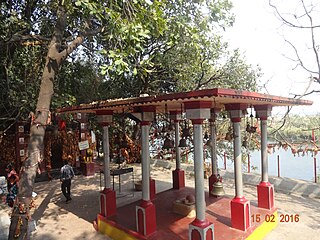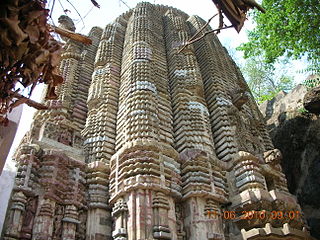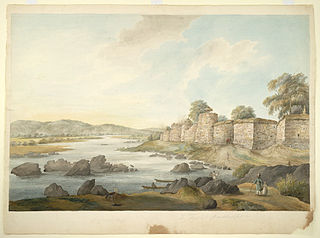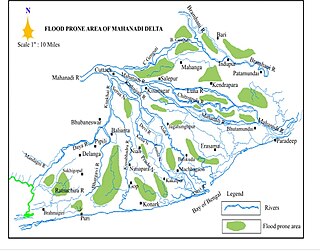Related Research Articles

Sambalpur District is a district in the western part of state of Odisha, India. The historic city of Sambalpur is the district headquarters.

Burla is a locality in Sambalpur city in the state of Odisha, India. It earlier had a Notified Area Council (NAC) until 2014 after which it was included in Sambalpur city under Sambalpur Municipal Corporation (SMC). It was earlier a small town on the banks of Mahanadi. One can reach this place by road with National Highway 6 which is one of the busiest trunk routes in India as it connects Hazira to Kolkata. Hirakud Railway Station is at one end of the town and a walking distance from the Mahanadi Coal Limited (MCL).

Kalahandi district is a district of western Odisha in India.

Bargarh District is an administrative district of Odisha state in eastern India. The city of Bargarh is its district headquarters. The district was carved out of the erstwhile district of Sambalpur on 1 April 1993.

Sambalpur is the fifth largest city in the Indian State of Odisha. It is located on the banks of river Mahanadi, with a population of 335,761. Prehistoric settlements have been recorded there. It is the home of the Sambalpuri sari.

Hirakud Dam is built across the Mahanadi River, about 10 kilometres (6.2 mi) from Sambalpur in the state of Odisha in India. It is the longest earthen dam in the world. Behind the dam extends a lake, Hirakud Reservoir, 55 km (34 mi) long. It is one of the first major multipurpose river valley projects started after India's independence. Hirakud Reservoir was declared a Ramsar site on 12 October 2021.

Hirakud is a small township located in Sambalpur in Odisha. It was a Notified Area Council (NAC) which was later included along with Burla in Sambalpur city to become a Municipal Corporation. This city is a hub of HINDALCO, an Indian aluminium and copper manufacturing company. Hirakud Dam, is one of the most visited tourist spot. It is one of the longest and largest dams in the world. It is constructed across the Mahanadi river between the Gandhi Minar in North and the Nehru Minar in the South, which connects these two hills. The shoreline spans around 640 km. This dam had a generating capacity of 290MW.
Western Odisha is the western part of the state of Odisha in India, extending from the Kalahandi district in the south to the Sundargarh district in the north.
Samasingha is a gram panchayat in the district of Jharsuguda in the state of Odisha in India. The block office and police station of Samasingha is Kolabira, site of the Kolabira fort. It is divided into fourteen wards. The MLA constituency is Jharsuguda and the MP constituency is Bargarh. The village is situated on the bank of the Bhede river, a tributary of the Mahanadi. Two small seasonal streams flow through the village, the larger is named Badbahal and the smaller Nalia. Bhugarapali, Junadihi, Belmunda, Jalapara/Jaladihi and Kumharmal are villages are in the neighbourhood of Samasingha. Other nearby places include Jharsuguda, Sambalpur, Kuchinda, Bamra and Bagdihi. The nearest place of tourist attraction is Gudguda. It is on the route between Sambalpur and Ranchi.
The Kosal state movement is an effort by people of the Western Odisha region of India to secede from the state of Odisha. Organizations like Western Odisha Yuva Manch (WOYM), Kosal Youth Coordination Committee (KYCC), Kosal State Coordination Committee (KSCC), Koshal Sena, Koshal Mukti Bahini and Koshal Mukti Morcha are mainly leading this.

Sambalpur is a district of Odisha. Sambalpur city is the headquarter of Sambalpur district. Sambalpur is the cultural capital of Western Odisha.
Odisha, is an eastern Indian state on the Bay of Bengal. It is known for its tribal cultures and its many ancient Hindu temples. During the ancient times, many small kingdoms existed now known as Western Odisha, which was ruled by local chieftains.Western Odisha, or the western part of Odisha, India, extends from the Bolangir district in the south to the Sundargarh district in the north.

Prem Ram Dubey was an Indian lawyer and politician. He was the founding father of the Kosal State Movement, which campaigns for statehood for Western Odisha.
Kosal Kranti Dal (KKD) is a regional political outfit of Odisha with particular focus on western Odisha which is known for its separatist movement for a separate Koshal state as per article 2 & 3 of Indian Constitution. KKD is mainly focusing on the creation of a separate Kosal state by the bifurcation of Odisha.The KKD was formed in the year 2007 with veteran Koshalbadi leader and potential advocate Pramod Mishra became its first president. Later on Bunde Dharua of Jharsuguda became the president. Now KKD central office is located at Jharsuguda and Narayana Mohapatra is the president.

The Jharsuguda–Vizianagaram line is a railway line in eastern India. It connects Jharsuguda,516 km (321 mi) from Howrah on the Howrah–Nagpur–Mumbai line, and Titlagarh, which in turn is connected with Vizianagaram, 820 km (510 mi) from Howrah on the Howrah–Chennai main line, and Raipur Junction, 830 km (516 mi) from Howrah on the Howrah–Nagpur–Mumbai line. There are several branch lines, like the 176 km (109 mi) line connecting Rayagada with Koraput on the Kothavalasa–Kirandul line. The line traverses Western Odisha and connects the Howrah–Nagpur–Mumbai line with the Howrah–Chennai main line. It covers small portions of Chhattisgarh and Andhra Pradesh.
Vedanta Jharsuguda Power Station is a coal based thermal captive power plant located near Jharsuguda town in Jharsuguda district in the Indian state of Odisha. The power plant was commissioned in July 2008, and is operated by Vedanta Resources. It supplies power to aluminum smelter of Vedanta Resources.
Bhikampali is a medium-sized village in the Jharsuguda district of Odisha, India. It is situated on the banks of Badkelo River in the foothill of Chhelia Pahad. The village is located at a distance of 60 km from the district headquarter of Jharsuguda. It is within the Brajarajnagar assembly constituency, and the Bargarh Parliament constituency. As of 2011 census, its population is 920.
Antarduli was a village in India, located in Sambalpur district in the state of Odisha, which is located on the eastern side of the country. It was one of least 249 villages partially or completely submerged by the construction of Hirakud Dam reservoir which was completed in 1957.

Hirlipali is a village in Attabira Tehsil of Bargarh district of Odisha, India. The village is located on the banks of canal that flows reservoir water from Hirakud Dam. It is about 10 km from Attabira and about 20 km from Bargarh town. The total geographical area of Hirlipali Gram Panchayat is 25.19 square kilometers, and has a total population of 8,320 peoples. There are about 1,817 households in Hirlipali Gram Panchayat

The 2022 Odisha floods were a series of floods in Odisha, which lasted from 14 August 2022 to 7 September 2022.
References
- ↑ "Hirakud dam: Displaced families seek rehabilitation". Archived from the original on 18 September 2019. Retrieved 24 April 2016.
- ↑ "Hirakud dam is failing, farmers are killing themselves". Hindustan Times. February 25, 2010. Archived from the original on February 28, 2010.
- ↑ "NDTV.com". www.ndtv.com. Retrieved 24 April 2016.
- ↑ Farmer suicide continues in Bargarh of Western Odisha [ permanent dead link ]
- ↑ "Farmer's suicide issue hots up". The Hindu . 2009-10-19. Archived from the original on 7 November 2012. Retrieved 24 April 2016.
- ↑ "Orissa's new name is Odisha". The Times of India. Retrieved 24 April 2016.